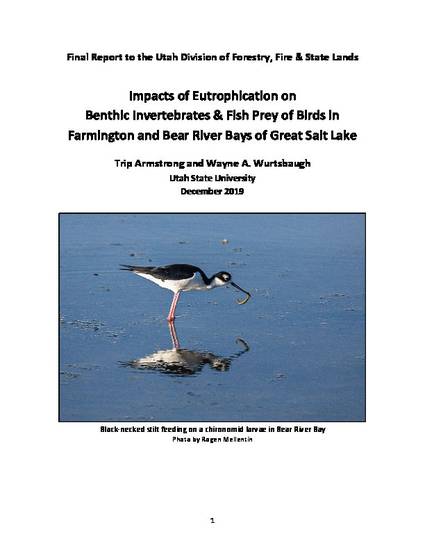
Article
Impacts of Eutrophication on Benthic Invertebrates & Fish Prey of Birds in Farmington and Bear River Bays of Great Salt Lake
Watershed Sciences Faculty Publications
Document Type
Report
Publisher
Utah State University
Publication Date
12-1-2019
Keywords
- Great Salt Lake,
- saline,
- salinity,
- insect,
- benthic,
- invertebrates,
- prey,
- limnology,
- eutrophication,
- nutrients,
- nitrogen,
- phosphorus,
- periphyton,
- phytoplankton,
- birds,
- macrophytes,
- monimolimnion,
- deep brine layer,
- AFDM,
- organic matter,
- sediments,
- diversity,
- Farmington Bay,
- Bear River Bay,
- abundance,
- biomass,
- temperature,
- oxygen,
- fish,
- vegetation,
- water quality,
- desiccation,
- water development,
- dust
Disciplines
Abstract
Farmington Bay’s watershed is primarily in the heavily populated metropolitan Salt Lake City, and consequently, it receives approximately 50% of its inflow from nutrient‐ rich wastewater releases. The high nutrient loads make it eutrophic and reducing the loading has been suggested to reduce blooms of toxic cyanobacteria. However, the bay also supports thousands of wading birds and waterfowl, and there is concern that reducing nutrient inflows might reduce the production of bottom‐dwelling insects and other invertebrates that the birds rely upon.
Citation Information
Armstrong, Trip, and Wurtsbaugh, Wayne A. "Impacts of Eutrophication on Benthic Invertebrates & Fish Prey of Birds in Farmington and Bear River Bays of Great Salt Lake." Utah State University, 2019, pp. 1-41.
